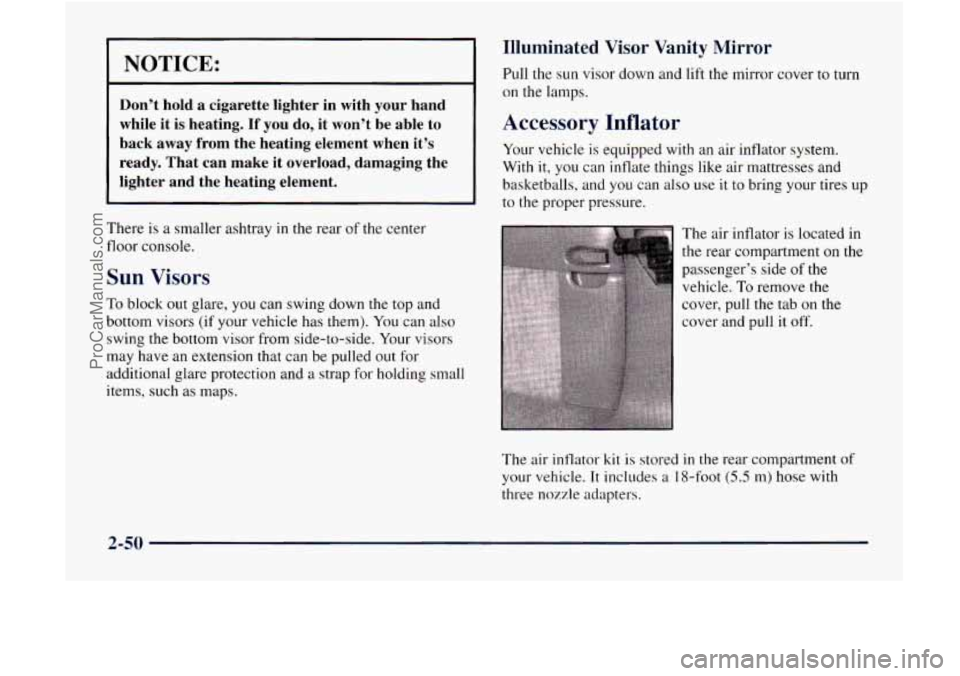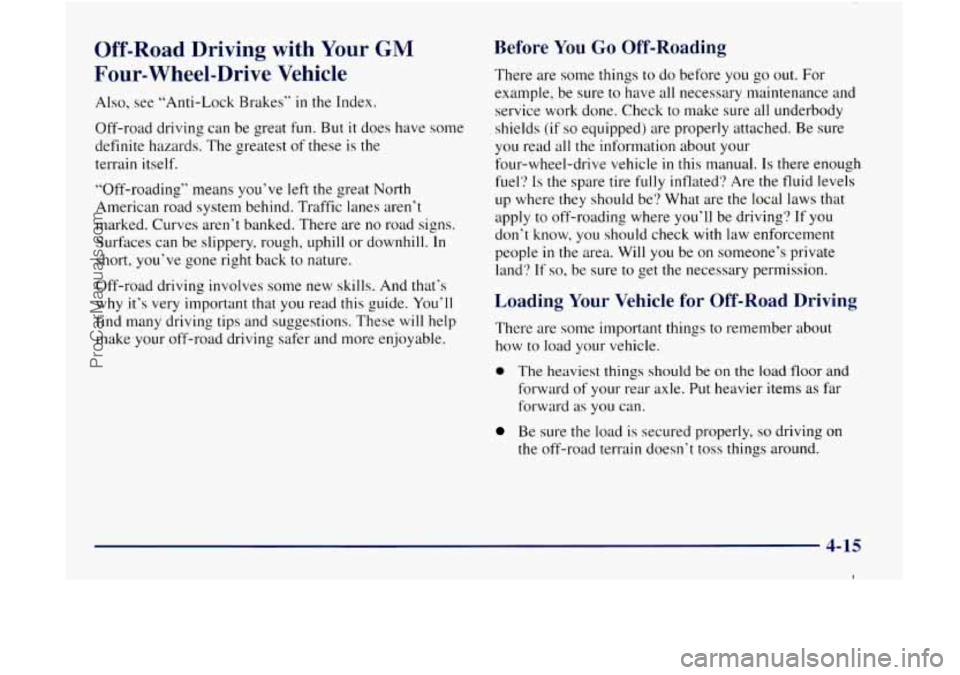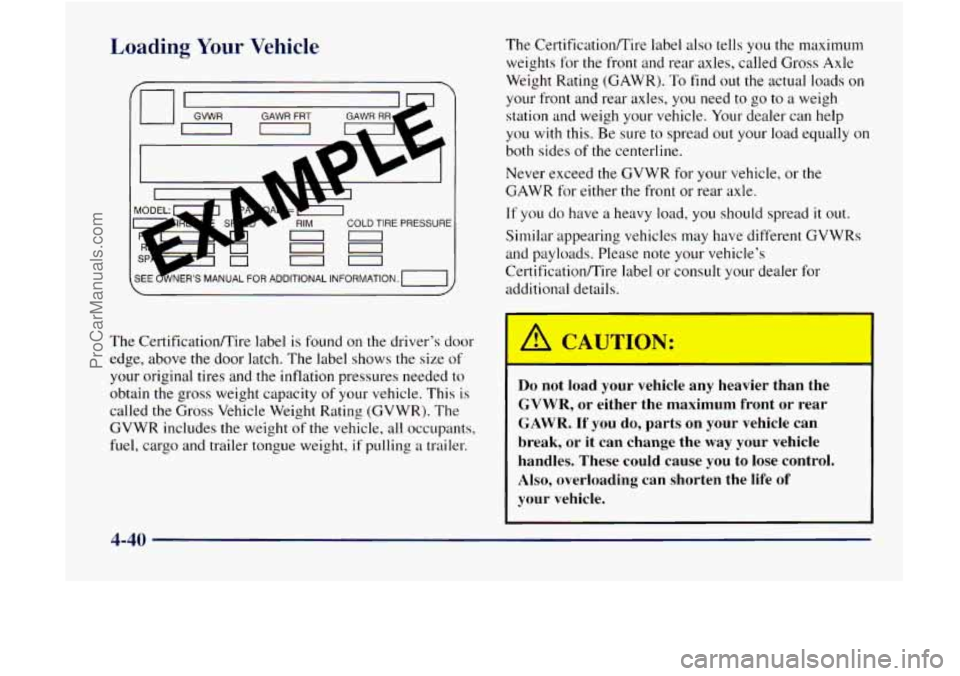flat tire GMC ENVOY 1998 Owners Manual
[x] Cancel search | Manufacturer: GMC, Model Year: 1998, Model line: ENVOY, Model: GMC ENVOY 1998Pages: 386, PDF Size: 20.33 MB
Page 2 of 386

The 1998 GMC Envoy Owner’s Manual
1-1
2- 1
3- 1
4- 1
5- 1
6-1
7- 1
8- 1
9-1
Seats and Restraint Systems
This section tells you how to use your seats and safe.ty belts properly. It also explains the “SIR” system.
Features and Controls
This section explains how to start and operate your vehicle.
Comfort Controls and Audio Systems
This section tells you how to adjust the ventilation and comf‘orr controls and how to operate your audio system.
Your Driving and the Road
Here you’ll find helpful information and tips about. the road and how to drive under different conditions.
Problems on the Road
This section tells what to do if you have a problem while driving, such as a flat tire or overheated engine, etc.
Service and Appearance Care
Here the manual tells you how to keep your vehicle running properly and looking good.
Maintenance Schedule
This section tells you when to perform vehicle maintenance and what fluids and lubricants to use.
Customer Assistance Information
This section tells you how to contact GMC for assistance and how to get service and owner publications.
It also gives you information on “Reporting Safety Defects” on page 8- 10.
Index
Heree‘s an alphabetical listing of almost every subject in this manual. You can use it to quickly find
something you want to read.
i
I
ProCarManuals.com
Page 111 of 386

NOTICE:
Don’t hold a cigarette lighter in with your hand
while
it is heating. If you do, it won’t be able to
back away from the heating element when it’s
ready. That can make it overload, damaging the
lighter and the heating element.
There is a smaller ashtray in the rear of the center
floor console.
Sun Visors
To block out glare, you can swing down the top and
bottom visors
(if your vehicle has them). You can also
swing the bottom visor from side-to-side. Your visors
may have an extension that can be pulled out for
additional glare protection and a strap for holding small
items, such
as maps.
Illuminated Visor Vanity Mirror
Pull the sun visor down and lift the mirror cover to turn
on the lamps.
Accessory Inflator
Your vehicle is equipped with an air inflator system.
With
it, you can inflate things like air mattresses and
basketballs, and you can also use it to bring your tires up
to the proper pressure.
The air inflator is located in
the rear compartment on the
passenger’s side
of the
vehicle.
To remove the
cover, pull the tab on the
cover and pull
it off’.
The air inflator kit
is stored in the rear compartment of
your vehicle. It includes a I %foot (5.5 m) hose with
three nozzle adapters.
2-50
ProCarManuals.com
Page 174 of 386

Off-Road Driving with Your GM
Four-Wheel-Drive Vehicle
Also, see "Anti-Lock Brakes" in the Index.
Off-road driving can be great fun. But
it does have some
definite hazards. The greatest of these is the
terrain itself.
"Off-roading" means you've left the great North
American road system behind. Traffic lanes aren't
marked. Curves aren't banked. There are no road signs.
Surfaces can be slippery, rough,
uphill or downhill. In
short, you've gone right back to nature.
Off-road driving involves some new skills. And that's
why it's very important that
you read this guide. You'll
find many driving tips and suggestions. These will help
make
your off-road driving safer and more enjoyable.
Before You Go Off-Roading
There are some things to do before you go out. For
example, be sure to have all necessary maintenance and
service work done. Check to make sure all underbody
shields
(if so equipped) are properly attached. Be sure
you read all the information about your
four-wheel-drive vehicle
in this manual. Is there enough
fuel? Is the spare tire fully inflated'? Are the fluid levels
up where they should be? What are the local
laws that
apply to off-roading where you'll be driving?
If you
don't know, you should check with
law enforcement
people
in the area. Will you be on someone's private
land'?
If so. be sure to get the necessary permission.
Loading Your Vehicle for Off-Road Driving
There are some important things to remember about
how to load your vehicle.
0 The heaviest things should be on the load floor and
forward of
your rear axle. Put heavier items as far
forward as you can.
Be sure the load is secured properly, so driving on
the off-road terrain doesn't toss things around.
4-15
I
ProCarManuals.com
Page 192 of 386

The exit speed is usually posted.
Reduce your speed according to your speedometer’
not
to your sense of motion. After driving for any distance
at higher speeds,
you may tend to think you are going
slower than you actually are.
Before Leaving on a Long Trip
Make sure you’re ready. Try to be well rested. If you
must start when you’re not fresh
-- such as after a day’s
work
-- don’t plan to make too many miles that first part
of the journey. Wear comfortable clothing and shoes you
can easily drive
in.
Is your vehicle ready for a long trip? If you keep it
serviced and maintained, it‘s ready to go. If it needs
service, have
it done before starting out. Of course,
you’ll find experienced and able service experts
in GM
dealerships all across North America. They’ll be ready
and willing to help if you need it.
Here are some things you can check before a trip:
0
0
0
0
0
0
0
WincJsl~ield Wcrshc~r- Fluid: Is the reservoir full? Are
all windows clean inside and outside?
Wiper Blcrdes: Are they in good shape?
Fuel, Elzgirze Oil, Other Flr.ds: Have you checked
all levels‘?
Lcunps: Are they all working? Are the lenses clean?
Tires: They are vitally important to a safe,
trouble-free trip.
Is the tread good enough for
long-distance drivingi? Are the tires all inflated
to the
recommended pressure?
Wecrther Forec*cr.sts: What’s the weather outlook
along your route? Should
you delay your trip a short
time to avoid
a major storm system?
A4crp.s: Do you have up-to-date maps?
4-33
I
ProCarManuals.com
Page 193 of 386

Highway Hypnosis
Is there actually such a condition as “highway
hypnosis”? Or
is it just plain falling asleep at the wheel?
Call
it highway hypnosis, lack of awareness,
or whatever.
There is something about an easy stretch
of road with
the same scenery, along with the
hum of the tires on the
road, the drone
of the engine, and the rush of the wind
against the vehicle that can make you sleepy. Don‘t let it
happen to
you! If it does, your vehicle can leave the
road in
less than CI second, and you could crash and
be injured
.
What can you do about highway hypnosis? First, be
aware that it can happen.
Then here are some tips:
Make sure your vehicle is well ventilated, with a
comfortably cool interior.
Keep your eyes moving. Scan the road ahead and to
the sides. Check your mirrors and your
instruments frequently.
If you get sleepy, pull off the road into a rest. service
or parking area and take
a nap, get some exercise, or
both. For safety, treat drowsiness on
the highway as
an emergency.
aLL - - ountain Roads
Driving on steep hills or mountains is different from
driving
in flat or rolling terrain.
If you drive regularly in steep country, or if you’re
planning to visit there, here are some tips that can make
your trips safer
and more elljoyable. (See ”Off-Road
Driving“
in the Index for information about driving
off-road.)
4-34
ProCarManuals.com
Page 199 of 386

Loading Your Vehicle
The CertificatiodTire label is found on the driver’s door
edge, above the door latch. The label shows the size of
your original tires and the inflation pressures needed to
obtain the gross weight capacity
of your vehicle. This is
called the Gross Vehicle Weight Rating (GVWR). The
GVWR includes the weight of
the vehicle, all occupants,
fuel, cargo and trailer tongue weight, if pulling a trailer. The
Certification/Tire label
also tells you the maximum
weights for the front and rear axles, called
Gross Axle
Weight Rating (GAWR).
To find out the actual loads on
your front and rear axles, you need to go to a weigh
station and weigh your vehicle. Your dealer can help
you with this. Be sure to spread out your load equally on
both sides of the centerline.
Never exceed the GVWR for your vehicle,
or the
GAWR for either the
front or rear axle.
If you do have a heavy load, you should spread it out.
Similar appearing vehicles may have different GVWRs
and payloads. Please note your vehicle’s
Certificatian/Tire label or consult your dealer for
additional details.
I
A (- %I---- - -,
Do not load your vehicle any heavier than the
GVWR, or either the maximum front or rear
GAWR. If you do, parts on your vehicle can
break,
or it can change the way your vehicle
handles. These could cause you to lose control. Also, overloading can shorten the life of
your vehicle.
4-40
ProCarManuals.com
Page 205 of 386

A B
If you’re using a weight-carrying hitch, the trailer
tongue (A) should weigh
10 percent of the total loaded
trailer weight
(B). If you’re using a weight-distributing
hitch, the trailer tongue
(A) should weigh 12 percent of
the total loaded trailer weight (B).
After you’ve loaded your trailer, weigh the trailer and
then the tongue, separately, to see if the weights are
proper. If they aren’t,
you may be able to get them right
simply by moving some items around in the trailer.
1 Total Weight on Your Vehicle’s Tires
Be sure your vehicle’s tires are inflated to the upper
limit for cold tires. You’ll find these numbers on the
CertificatiodTire label on the driver’s door edge, above
the door latch, or see “Tire Loading”
in the Index. Then
be sure
you don’t go over the GVW limit for your
vehicle, including the weight
of the trailer tongue.
Hitches
It’s important to have the correct hitch equipment.
Crosswinds, large trucks going by and rough roads are a
few reasons why you’ll need the right hitch. Here are
some rules to follow:
0 If you’ll be pulling a trailer that, when loaded, will
weigh more than
3,500 lbs. (1 589 kg), be sure to use
a properly mounted, weight-distributing hitch and
sway control of the proper size. This equipment is
very important for proper vehicle loading and good
handling when you’re driving.
0 Will you have to make any holes in the body of your
vehicle when you install
a trailer hitch?
If you do, then be sure to seal the holes later when
you remove the hitch. If you don’t seal them, deadly
carbon monoxide (CO) from your exhaust can get
into your vehicle (see “Carbon Monoxide” in the
Index). Dirt and water can, too.
4-46
ProCarManuals.com
Page 212 of 386

Section 5 Problems on the Road
Here you’ll find what to do about some problems that can occur on the road.
5-2
5-2
5-3
5-7
5-11
Hazard Warning Flashers
Other Warning Devices
Jump Starting
Towing
Your Vehicle
Engine Overheating Engine
Fan Noise
If a Tire Goes Flat
Changing a Flat Tire
If You’re Stuck: In Sand, Mud,
Ice or Snow
5-20
5-20
5-2 1
5-32
ProCarManuals.com
Page 231 of 386

Engine Fan Noise
This vehicle has a clutched engine cooling fan. When the
clutch is engaged, the fan spins faster to provide more air
to cool the engine. In most everyday driving conditions,
the clutch is
not engaged. This improves fuel economy and
reduces
fan noise. Under heavy vehicle loading, trailer
towing and/or high outside temperatures, the fan speed
increases when the clutch engages.
So you may hear an
increase in fan noise. This is normal and should not be
mistaken
as the transmission slipping or making extra
shifts. It is merely the cooling system functioning properly.
The fan will slow down when additional cooling is not
required and the clutch disengages.
You may
also hear this fan noise when you start the
engine. It will go away
as the fan clutch disengages.
If a Tire Goes Flat
It’s unusual for a tire to “blow out” while you’re driving,
especially if you maintain your tires properly.
If air goes
out of
a tire, it’s much more likely to leak out slowly.
But
if you should ever have a “blowout,” here are a few
tips about what to expect and what to do:
If
a front tire fails, the flat tire will create a drag that
pulls the vehicle toward that side.
Take your foot off the
accelerator pedal and grip
the steering wheel firmly.
Steer to maintain lane position, and then gently brake to
a stop well out of the traffic lane.
A rear blowout, particularly on a curve, acts much like a
skid and may require the same correction you’d use in a
skid. In any rear blowout, remove your foot from the
accelerator pedal. Get the vehicle under control by
steering the
way you want the vehicle to go. It may be
very bumpy and noisy, but you can
still steer. Gently
brake to
a stop -- well off the road if possible.
If a tire goes flat, the next part shows how to use your
iacking equipment to change
a flat tire safely. u Y a. c
5-20
ProCarManuals.com
Page 232 of 386

Changing a Flat Tire
If a tire goes flat, avoid further tire and wheel damage
by driving slowly to a level place. Turn on
your hazard
warning flashers.
A CAUTION:
I
Changing a tire can cause an injury. The vdcle
can slip
off the jack and roll over you or other
people. You and they could be badly injured.
Find a level place to change your tire. To help
prevent the vehicle from moving:
1. Set the parking brake firmly.
2. Put the shift lever in PARK (P).
3. lbrn off the engine.
4. Put the wheel blocks at the front and
rear of the tire farthest away from the
one being changed. That would be the
tire on the other side of the vehicle,
at
the opposite end.
The following steps will tell you how to use the jack and
change a tire.
5-21
ProCarManuals.com